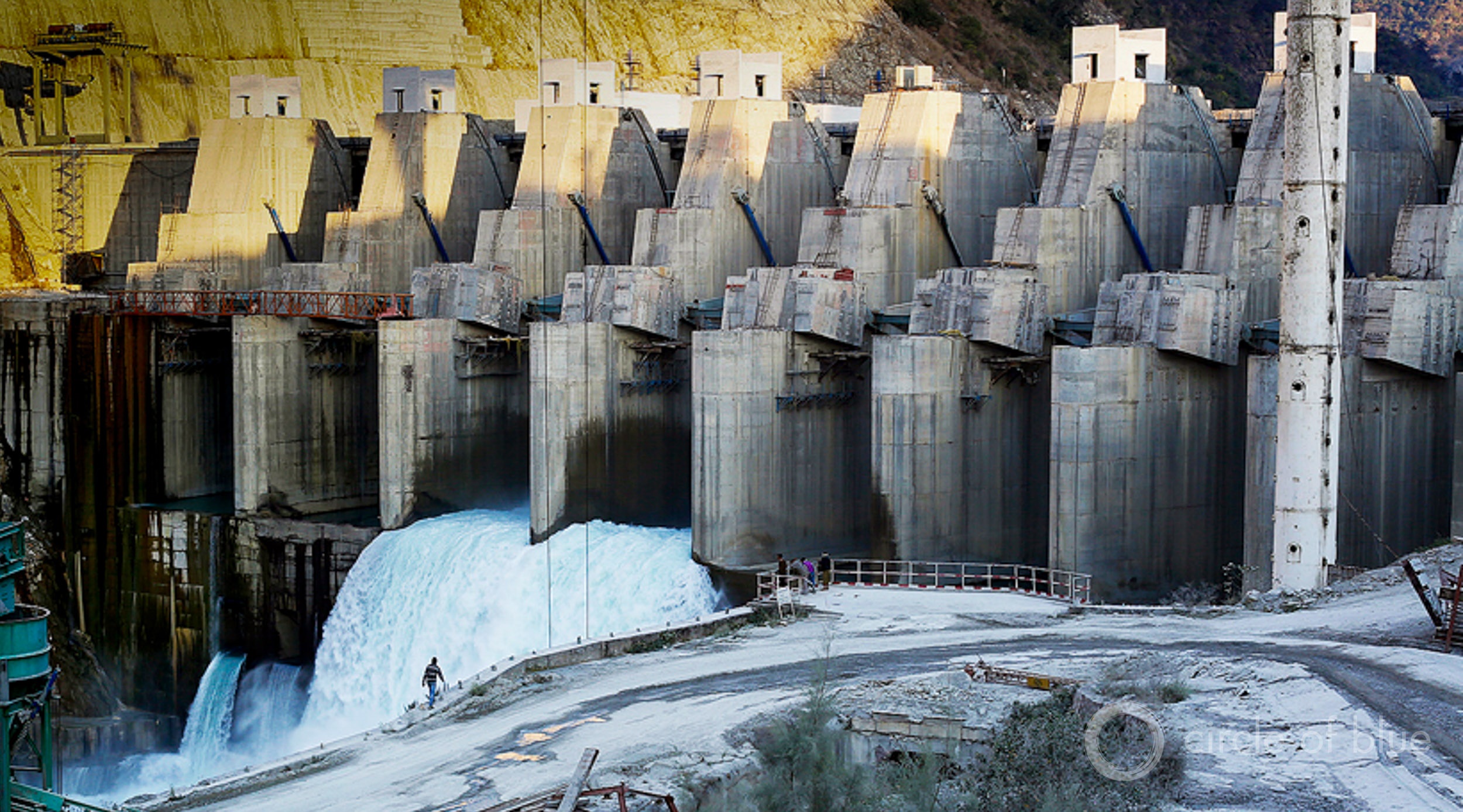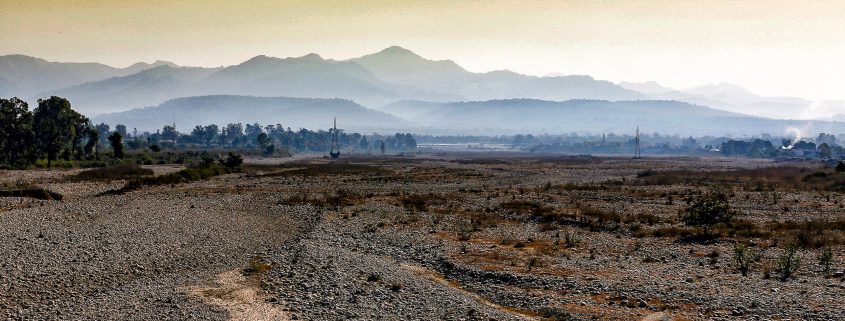India’s Severe Drought Causing Havoc
Water scarcity forces millions of people off of farms and into teeming cities.

The latest national drought assessment shows that 19 of the 36 states and territories in India are experiencing moisture deficits of at least 50 percent when compared to normal years of rainfall. Above, a dry riverbed in Uttarakhand, a Himalayan state. Photo © Dhruv Malhotra
By Keith Schneider, Circle of Blue
On Monday, as it’s been for weeks now, hundreds of farmers from mountainous Bundelkhand, a drought-ravaged region of north central India, climbed down from the Mahakaushal Express and headed for the highway underpasses near Delhi’s Nizamuddin railway station. They are refugees from an agricultural area that straddles Uttar Pradesh and Madhya Pradesh, two states that have been tormented by India’s two-year dry spell that is killing crops, shutting down power plants, escalating joblessness and putting increasing pressure on Prime Minister Narendra Modi and his aides.
“This year has been the worst,” Gahna Devi, a 55-year-old grower told a reporter from the Times of India. She said her village, with 2,000 residents, is deserted as farmers and their families leave to find work, most of them as laborers living on the streets in Delhi. “Only 100, mostly the ill and the aged, are still in their homes,” she reckoned.
Dry, Dry Experience
One of the driest two-year periods in recent India history affects roughly half of the country, and has joined the hottest week ever recorded. Temperatures soared past 51 degrees centigrade (124 degrees Fahrenheit) in May in Rajasthan, a desert state southwest of Delhi. Water scarcity and blinding heat are causing havoc in the farm and energy sectors, the two largest users of water in India.
The latest national drought assessment shows that 19 of the 36 states and territories are experiencing moisture deficits of at least 50 percent when compared to normal years of rainfall. Four areas have deficits of 60 percent to 90 percent, according to the India Meteorological Department. Water levels in India’s 91 reservoirs are at the lowest points in a decade and on May 26 stood at 17 percent of their total storage capacity, according to the Central Water Commission. Water levels are falling in aquifers, which supply 85 percent of drinking water, according to WaterAid, an international charity.
The country’s farms, most of them less than two acres, are shutting down. Roughly 700 million of the country’s 1.3 billion residents are tied to agriculture. Millions of farmers and farm laborers are packing into India’s already teeming cities, adding to joblessness, putting pressure on municipal services, and causing rising social instability.
The Foreign Agriculture Service, a research unit of the U.S. Department of Agriculture projects that wheat production will tumble so far that India is projected to be in the market this year for 1 million metric tons of imports.
Consequences To Energy
In the energy sector, the drought is aggravating India’s chronic shortages of electricity. Low water levels have forced coal-fired power plants to shut down due to lack of cooling water, and substantially lowered hydropower production.

In March 2016 and April 2016, due to severe drought, generation from hydropower projects was 19 percent and 17 percent lower compared to the same months the previous year. Here, a hydropower project in Srinagar, a Himalayan hill city in Uttarakhand. Photo © Dhruv Malhotra
In Karnataka, a highland state in southeast India, the 1,720-megawatt Raichur Thermal Power Station has operated far below its capacity due to low water levels in the Krishna River. One or more of the plant’s eight generating units have shut down almost continuously due to the lack of water since February, Shankar Sharma, a power policy analyst from Karnataka told Circle of Blue.
“There have been massive impacts of drought on the lives of the ordinary people in a country largely dependent on rain water,” said Sharma in an email message. “Since coal power plants depend on massive quantities of fresh water, the operation of many coal power plants in different parts of the country have been affected. Many power plants were shut either fully or partially. The situation may continue like this until the onset of monsoon rains in June and July.”
Electrical generation losses also are occurring in India’s hydropower sector as a result of the drought, according to Himanshu Thakkar, the founder and director of the South Asia Network on Dams, Rivers and People, a non-profit research group based in Delhi. “According to the Central Electric Authority, total hydropower generation during the 2015-2016 period was six percent below the 2014-2015 period, even as the operating hydropower capacity in 2015-2016 was 1,151 megawatts higher than previous year,” Thakkar wrote in an email message. “This difference is even more pronounced in March 2016 and April 2016 when generation from hydropower projects in these months was 19 percent and 17 percent lower compared to the same months the previous year.”
The drought is so severe that state governments are dispatching trains of water tankers to transport millions of liters to dry districts in Rajasthan and other states. The national government has sent teams of advisors to the most heavily hit regions to assess crop damage and industrial effects from the drought.
Prime Minister Narendra Modi has come under sharp criticism for his government’s slow response to the drought. Government aid to farmers is seen as inadequate, and policy responses, while viewed as useful in the long-term, are criticized as impractical in the short term.
In May, for instance, Modi met with top leaders of Uttar Pradesh and noted the usefulness of technologies like remote sensing and satellite imaging for conserving water. “The need to change cropping patterns based on scientific advice, use of drip and sprinkler irrigation for increasing water use efficiency, community participation, especially women, for better water management, was stressed,” said the prime minister.
He also noted that recycling treated urban wastewater is useful for irrigating farms. Modi also is promoting a $US 165 billion diversion scheme to shift water supplies in 37 river basins to another to serve drought-prone regions.
Modi Management Criticized
Opponents criticize the diversion scheme as expensive, ecologically damaging, and reckless. Critics also note that nearly every Indian farmer is too poor to acquire drip irrigation systems and other water conserving tools without government aid. And only 5 percent of India’s wastewater is treated to remove pollutants.

One of the driest two-year periods in recent India history affects roughly half of the country, and has joined the hottest week ever recorded. Here a young girl waits at a Delhi well for water. Photo © J. Carl Ganter / Circle of Blue
“The government does not have a strategy to deal with the permanent water shortages that we’ve been seeing for a decade,” Rajendra Singh, winner of the 2015 Stockholm Water Prize and one of India’s premier water policy experts, told the Associated Press.
The most recent findings by the National Meteorological Department and India’s universities indicate that this year’s severe drought is part of a developing climate pattern. Over the past three decades, the frequency of drought years has been increasing.
The period between 1950 and 1989 had 10 drought years. Since 2000, there have been five droughts. The frequency is set to increase between 2020 and 2049, meteorologists project in a research paper published by Current Science Association and the Indian Academy of Science.
“I am seeing a bunch of changes in weather conditions which seem to be linked to climate change,” M Rajshekhar, a reporter for Scroll.in, an Indian news organization, in a message to Circle of Blue. “In the north Indian state of Punjab, scientists are noticing that — over the last 15 years — the behavior of the mid-latitude westerlies is changing. During the monsoon and winter months, these winds are extending far more southwards than earlier. This is changing rainfall patterns in the state.
“South India is seeing changes in rainfall patterns as well. Over the last 25 years, the southwest monsoon has all but vanished from Tamil Nadu. It used to account for 20 percent of rainfall in the state. Over the last 15 or so years, the northeast monsoon, which provides 70 percent of the rain for this state, has begun changing too.”
Short-term relief is in the forecast. The summer monsoon is beginning, with showers sweeping across southern India. The wet weather, though, will not resolve India’s long-term water crisis, caused by the growing demands of India’s relentless population growth and the country’s disrupted cycles of moisture and heat.
Circle of Blue’s senior editor and chief correspondent based in Traverse City, Michigan. He has reported on the contest for energy, food, and water in the era of climate change from six continents. Contact
Keith Schneider













